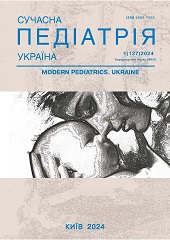The case of Kinsburn’s Encephalopathy in a child with neuroblastoma of posterior mediastinum
DOI:
https://doi.org/10.15574/SP.2024.137.138Keywords:
neuroblastoma, paraneoplastic syndrome, opsoclonus-myoclonus, Kinsburn’s encephalopathyAbstract
Opsoclonus-myoclonus-ataxia syndrome (OMAS) is an autoimmune rare disease of the central nervous system with lesion of the cerebellum and its ligaments.
Purpose - to present a case of the rare Kinsburn’s Encephalopathy - OMAS and to attract the attention to its timely diagnosis.
Clinical case. A child at the age of 1 year and 9 months was observed in the neurological department of the National Children’s Specialized Hospital “OKHMATDYT”. Neurological status: eyes opsoclonus, truncal tremor, ataxia of the cerebellum. There were also changes in behavior and a sleep disorder. She became sick in 1 month after acute respiratory infection. True diagnosis was made: Kinsburn’s Encephalopathy - opsoclonus-myoclonus syndrome. A study of the child’s immune status was made and, most importantly, computerized tomography (CT) of the whole body. Mediastinal neuroblastoma was diagnosed.
In addition to the diagnosis, the child receive adequate therapy - intravenous immunoglobulin at a dose of 2 g/kg for a 5-day course. On the background of the received therapy, the child was marked with positive dynamics, she began to walk by herself, the atactic syndrome diminished, opsoclonus remained unchanged.
Consequently, the main cause of autoimmune defeat of the nervous system was detected and the child was directed to the further examination and treatment to the Cancer Institute of the National Academy of Medical Science of Ukraine.
Radical removal of the left hemopleura neuroblastoma was made. According to the results of morphological and immunohistochemistry tests, the phenotype obtained in the material of the operation is characteristic of the neuroblastoma (ICD-O code 9500/3), pT1bpN0M0, negative form. In the future, the child continued to receive courses of immunosuppressive therapy.
The research was carried out in accordance with the principles of the Helsinki Declaration. The informed consent of the patient was obtained for conducting the studies.
No conflict of interests was declared by the authors.
References
Bravo J, López-Almaraz R, Mateos M. (2016, Mar 16). Neuropsychological profile in opsoclonus-myoclonus-ataxia syndrome presenting as neuroblastic tumours. Rev Neurol. 62(6): 249-257.
De Grandis E, Parodi S, Conte M. (2009). Long-term follow-up of neuroblastoma-associated opsoclonus-myoclonus-ataxia syndrome. Neuropediatrics. 40: 103-111. https://doi.org/10.1055/s-0029-1237723; PMid:20020394
Green D, Lim M, Lang B et al. (2016, Jul). Sensory Processing Difficulties in Opsoclonus-Myoclonus Syndrome: A Pilot Project of Presentation and Possible Prevalence. J Child Neurol. 31(8): 965-970. https://doi.org/10.1177/0883073816634856; PMid:26994071
Kinsbourne M. (1962). Myoclonic encephalopathy of infancy. J Neurol Neurosurg Psychiatr. 25: 271e6. https://doi.org/10.1136/jnnp.25.3.271; PMid:21610907 PMCid:PMC495454
Ma GM, Chow JS, Taylor GA. (2019, Apr). Review of paraneoplastic syndromes in children. Pediatr Radiol. 49(4): 534-550. https://doi.org/10.1007/s00247-019-04371-y; PMid:30877339
Pang KK, de Sousa C, Lang B, Pike MG. (2010). A prospective study of the presentation and management of dancing eye syndrome/opsoclonus-myoclonus syndrome in the United Kingdom. Eur J Paediatr Neurol. 14: 156-161. https://doi.org/10.1016/j.ejpn.2009.03.002; PMid:19423368
Park C, Aljabban I, Fanburg-Smith JC. (2019, Dec 19). Pediatric whole body MRI detects causative ovarian teratoma in opsoclonus myoclonus syndrome. Radiol Case Rep. 15(3): 204-209. https://doi.org/10.1016/j.radcr.2019.11.010; PMid:31890069 PMCid:PMC6928268
Rudnick E, Khakoo Y, Antunes NL. (2001, Jun). Opsoclonus-myoclonus-ataxia syndrome in neuroblastoma: clinical outcome and antineuronal antibodies-a report from the Children's Cancer Group Study. Med Pediatr Oncol. 36(6): 612-622. https://doi.org/10.1002/mpo.1138; PMid:11344492
Storz C, Bares R, Ebinger M. (2019, Aug 20). Diagnostic value of whole-body MRI in Opsoclonus-myoclonus syndrome: a clinical case series (3 case reports). BMC Med Imaging. 19(1): 70. https://doi.org/10.1186/s12880-019-0372-y; PMid:31429709 PMCid:PMC6701085
Urman G, Leivi M, Chamorro N et al. (2019). Opsoclonus myoclonus syndrome secondary to abdominal neuroblastoma. Presentation of a pediatric clinical case. Arch Argent Pediatr. 117(6): 651-654.
Downloads
Published
Issue
Section
License
Copyright (c) 2024 Modern pediatrics. Ukraine

This work is licensed under a Creative Commons Attribution-NonCommercial 4.0 International License.
The policy of the Journal “MODERN PEDIATRICS. UKRAINE” is compatible with the vast majority of funders' of open access and self-archiving policies. The journal provides immediate open access route being convinced that everyone – not only scientists - can benefit from research results, and publishes articles exclusively under open access distribution, with a Creative Commons Attribution-Noncommercial 4.0 international license (СС BY-NC).
Authors transfer the copyright to the Journal “MODERN PEDIATRICS. UKRAINE” when the manuscript is accepted for publication. Authors declare that this manuscript has not been published nor is under simultaneous consideration for publication elsewhere. After publication, the articles become freely available on-line to the public.
Readers have the right to use, distribute, and reproduce articles in any medium, provided the articles and the journal are properly cited.
The use of published materials for commercial purposes is strongly prohibited.

